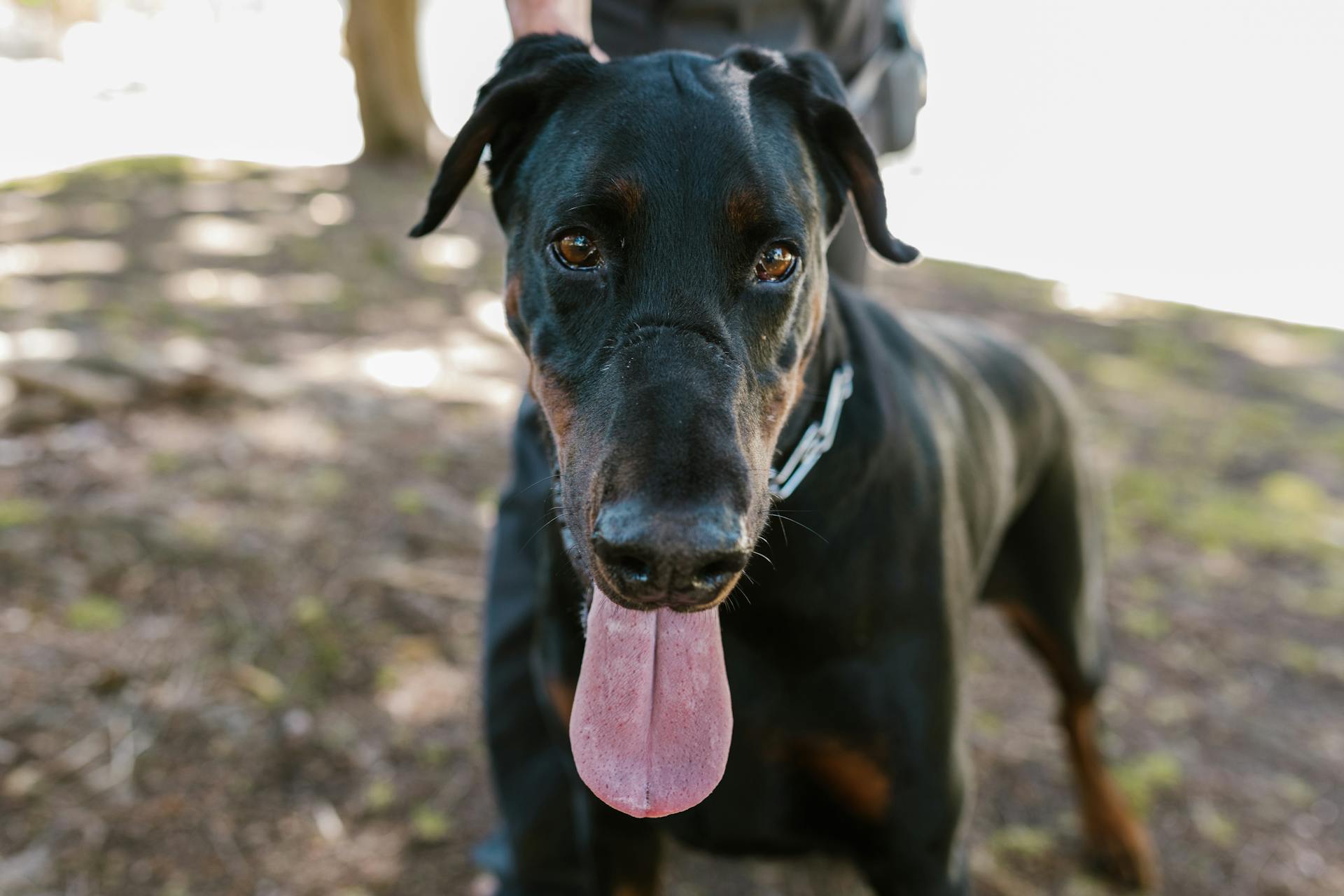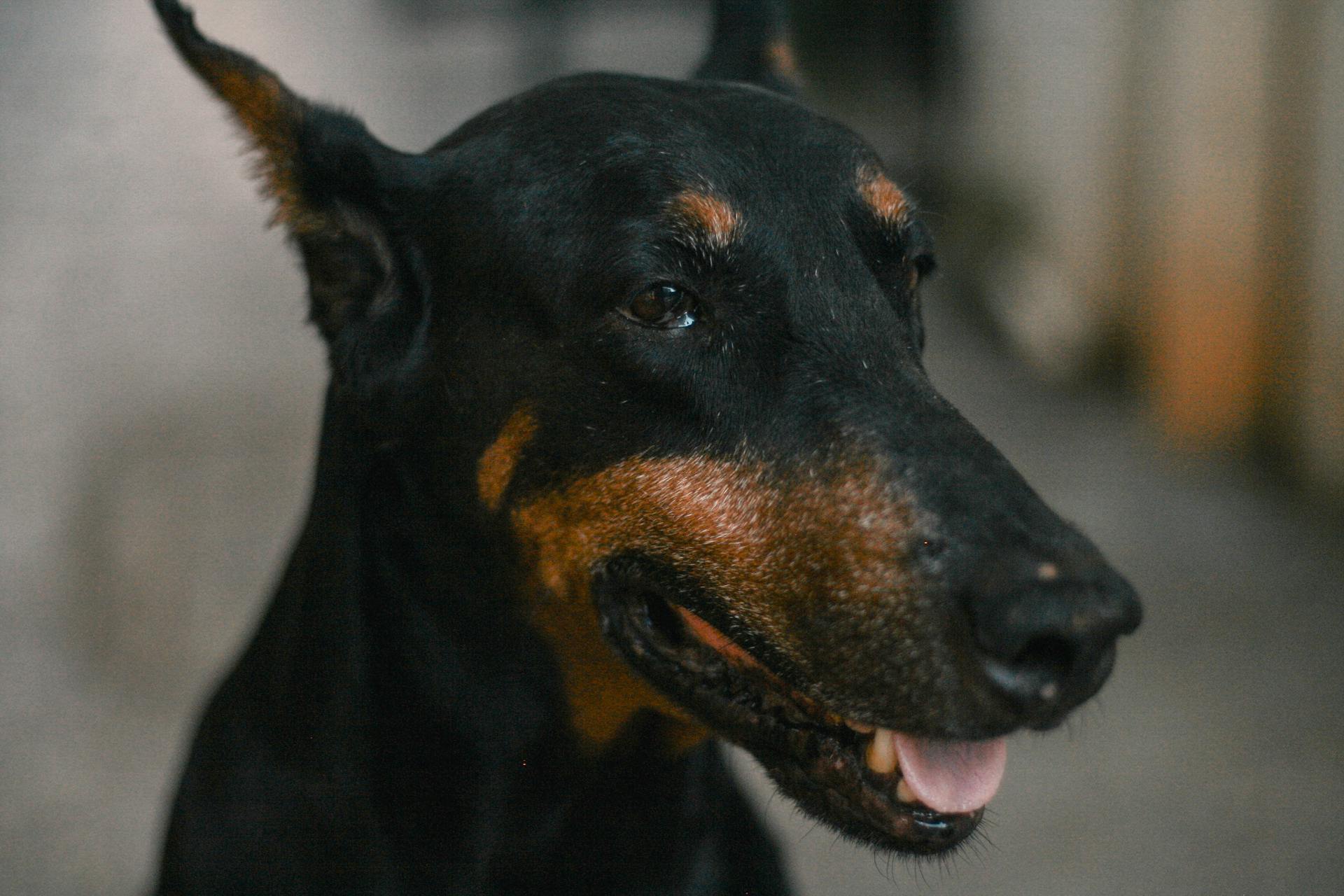
Doberman dog aggression is a serious concern for many owners. Doberman Pinschers are often stereotyped as aggressive breeds, but is this reputation justified?
Doberman Pinschers are naturally protective of their families, which can sometimes be misinterpreted as aggression. They have a strong instinct to defend their loved ones.
According to the American Temperament Test Society, Doberman Pinschers have a passing rate of 71%, which is higher than many other breeds. However, this doesn't mean they're immune to aggression issues.
Proper socialization and training can go a long way in preventing aggression in Doberman Pinschers. If they don't receive enough socialization, they may become wary of strangers and exhibit aggressive behavior.
Explore further: Dog Training for Socialization
Understanding Doberman Aggression
Aggression in Dobermans can manifest in various ways, including growling, snapping, biting, or displaying dominant behaviors. Recognizing these signs is crucial to addressing the issue promptly.
Aggression is a complex and serious behavior problem in dogs, and Dobermans are no exception. Unchecked aggression can lead to severe consequences such as bites, destructive behavior, or territorial aggression.
You might like: Are Dobermans the Best Guard Dogs
Prevention is the best approach, but if you notice any concerning behavior in your Doberman, it's essential to seek professional help from a qualified dog trainer or behaviorist experienced in working with Dobermans.
Understanding and identifying the specific types of aggression your Doberman displays is a crucial first step in addressing the behavior. This knowledge is essential for responsible pet ownership and ensures the safety and well-being of both your dog and the people around them.
Some common signs of potential aggression in Dobermans include body stiffness, growling, lunging without making contact, showing teeth, and snarling. These warning signs can indicate that your Doberman is about to bite.
Here are some specific signs to look out for:
- Barking, straining, biting, nipping, or lunging.
- Standing still and stiff with ears forward, mouth closed, tail high, hackles raised.
- Growling or baring teeth.
- Blocking paths of people or other dogs.
- Barging through doors or gates ahead of you.
- Demanding attention.
- Resource guarding.
- Mounting people’s legs or other dogs.
- Approaching another dog from the side and placing their head on the other dog’s back/shoulder.
- Inserting themselves between you and another person or dog.
If your Doberman exhibits any of these behaviors, they may have aggression issues.
Prevention and Training
Proper socialization and training are crucial for raising a well-behaved Doberman Pinscher. Start socializing your Doberman as early as possible, ideally during the critical socialization period that occurs between 3 and 14 weeks of age.
Exposing your puppy to different people, including children and individuals wearing hats or uniforms, is essential for their development. Introduce them to various environments, sounds, and objects to ensure they become comfortable in different situations.
Consistency is key to ensuring that your Doberman learns and retains the commands. Basic obedience training is essential, and teaching your Doberman basic commands such as sit, stay, come, and heel is a great place to start.
Use positive reinforcement techniques, rewarding them with treats, praise, and play when they exhibit the desired behaviors. This approach is more effective and humane than punitive measures.
Exposing your dog to well-trained dogs and various environments from a young age can help them become well-adjusted and confident. Love your dog by providing training, guidance, and correcting unwanted behaviors.
Dobermans are energetic dogs that require regular exercise and mental stimulation to prevent boredom or frustration. Provide your Doberman with exercise and mental stimulation every day to keep them healthy and de-stressed.
Establishing clear rules and boundaries is essential for preventing confusion and reducing frustration. Consistently enforce these rules to ensure a happy and secure relationship with your dog.
Here's an interesting read: Dog Training Basic Obedience Lesson Plan
What Causes Aggression?
Aggression in Dobermans can stem from inadequate socialization. This can lead to a lack of confidence and adaptability in new situations.
Genetics also play a role in temperament, and choosing a reputable breeder who focuses on producing well-tempered dogs is essential. Responsible breeders take into account not just physical traits but also temperament when selecting breeding pairs.
Early and ongoing socialization is crucial in shaping a Doberman's behavior, teaching them to be comfortable and well-behaved in different settings. Exposing Dobermans to various people, animals, environments, and situations from a young age helps develop confidence and adaptability.
Traumatic events, lack of proper care or training, and insufficient attention can contribute to aggressive behaviors in Dobermans. Genetics can also predispose certain breeds or individual dogs to aggression.
If both parents are aggressive, the offspring will likely be more aggressive than other dogs. It's not always easy to determine if your Doberman has inherited aggression, which often shows up as fear or anxiety in response to a trigger.
You might like: Dobermans Good Apartment Dogs
Addressing Aggression
Recognizing and addressing aggressive behavior in Dobermans is crucial, and prevention is the best approach. If you notice any concerning behavior, such as growling, snapping, or biting, seek professional help from a qualified dog trainer or behaviorist experienced in working with Dobermans.
A professional can assess the situation, identify potential triggers, and develop a behavior modification plan tailored to your Doberman's specific needs. They can help you implement strategies to manage and modify the aggressive behavior, ensuring the safety of everyone involved.
Treating aggression requires time, patience, and consistency. Stay calm, celebrate progress, and persist in your efforts to help your dog overcome aggression.
To address aggression in Dobermans, start by consulting a veterinarian to rule out any medical issues contributing to your dog's aggression. Then, seek guidance from a certified dog trainer or behaviorist who can assess your dog's behavior and develop a tailored treatment plan.
If you're experiencing difficulties with your Doberman's behavior, consult a professional dog trainer or behaviorist for guidance. Unchecked aggression in dogs can lead to serious consequences, including injury to people or other animals.
Check this out: How to Become a Dog Trainer for Service Dogs
Here are some key steps to take when addressing aggression in your Doberman:
- Identify the triggers that provoke aggressive behavior in your dog through careful observation and keeping a journal to track situations or stimuli that elicit aggressive responses.
- Implement behavior modification techniques with a professional, using positive reinforcement, desensitization, and other methods to change your dog's emotional response to triggers and encourage appropriate behaviors.
- Modify your dog's environment to reduce opportunities for aggression and minimize exposure to triggers, using tools such as baby gates, crates, or muzzles.
- Set clear rules and boundaries, practicing consistency. Use positive reinforcement for desirable behaviors and corrections to reduce undesirable behaviors.
Responsible Ownership
Owning a Doberman requires a long-term commitment to providing love, guidance, and proper care. They thrive in an environment where they receive attention and care.
Investing time and effort into their training, socialization, exercise, and overall well-being is crucial for a well-rounded and well-behaved Doberman. This includes educating yourself about the breed's characteristics, needs, and potential challenges.
Being a responsible owner means being prepared to invest resources into your Doberman's care, and being a positive ambassador for the breed to help dispel misconceptions.
Intriguing read: Chow Dog Breed Aggression
Abuse and Mistreatment
Abuse and mistreatment can have severe consequences on a Doberman's behavior and temperament. A dog that is abused may become aggressive towards people or other animals.
Mistreated dogs often subtly show their aggression, redirecting it toward anything they perceive as a threat instead of the animal or person responsible for the abuse. This can be a sign that they're still reeling from past trauma.
Dobermans who have been abused will often not enjoy being around people or other animals. They may even become aggressive towards those they know and attempt to protect themselves from the threat of abuse again.
Dogs learn right from wrong by the way you treat them, and punishing your Doberman puppy for acting aggressively can actually make things worse. This can lead to more aggression with time.
An adult Doberman's size and strength make them a formidable force, and if they lash out when feeling threatened, they can easily injure another dog or person.
Responsible Ownership and Breed Education
Owning a dog is a long-term responsibility. It's essential to understand the commitment required to raise a well-rounded and well-behaved dog.
Educate yourself about your dog's breed characteristics, needs, and potential challenges. This will help you provide the best possible care for your furry friend.
A well-cared-for dog thrives in an environment where they receive love, guidance, and proper care. This includes regular exercise, training, and socialization.
Investing time and effort into your dog's training and socialization is crucial for their development. It's also essential to be prepared to invest resources into their overall well-being.
Owning a dog is not just about providing for their physical needs, but also about being a responsible ambassador for the breed. By promoting positive experiences and responsible breeding practices, we can contribute to a better understanding of the breed.
Here's an interesting read: All Breed Dog Training
Statistics and Safety
Doberman Bite Statistics are a concern for many people. Dobermans have been responsible for almost 23 documented attacks since 1982, including 12 child victims, eight deaths, and 12 maimings.
Their bite force is significant, with a force of about 230 PSI, which is enough to cut through skin, sever arteries, and shatter bones. Some reports suggest their bite force could be even stronger, approaching 600 PSI.
Dobermans are also extremely fast and agile, making them a formidable opponent. They have high energy levels and spirit, which means they will not give up the chase easily.
Discover more: Pitbull Dog Bite Force
Bite Statistics

Dobermans are known to be quite aggressive, and the statistics back it up. Between 1982 and 2013, there were almost 20 documented attacks by Dobermans, with 9 of them involving child victims.
These attacks resulted in 7 documented deaths and 10 maimings. The statistics were updated in 2022, showing a total of 23 attacks since 1982, including 12 child victims, 8 deaths, and 12 maimings.
Dobermans have a bite force of around 230 PSI, which is strong enough to cut through skin, sever arteries, and shatter bones. Some reports even suggest their bite force can reach up to 600 PSI, although the data is inconclusive.
Raw strength isn't everything, though - Dobermans are also extremely fast and agile, making them a formidable opponent.
Explore further: Can Dobermans Be Service Dogs
Assessing Bite Wounds Severity
A single bite injury from a small dog can be life-threatening.
Even a Doberman, specifically bred for violence and policing, can inflict serious injury. In October 2022, a 3-year-old girl in the UK was left with life-threatening injuries after a Doberman attack.
The severity of a bite wound depends on various factors, including the size and breed of the dog.
A senior citizen in the UK suffered a bite wound to the head after being pounced on by a Doberman in 2022.
In Nevada, a man who ordered his Doberman to attack a deputy faced a charge of assault with a deadly weapon, highlighting the potential danger of Doberman attacks.
A Doberman's bite can be particularly severe due to its powerful jaws and sharp teeth.
Sources
- https://blog.tryfi.com/are-doberman-pinscher-aggressive/
- https://www.pet365.co.uk/are-dobermans-aggressive/
- https://www.ancillaryk9.com/blog/understsanding-aggression-in-dogs-signs-your-dog-has-aggresion-issues
- https://www.palermolawgroup.com/blog/doberman-dog-attacks-facts
- https://www.askthedogguy.com/seriously-aggressive-doberman-possible-reasons/
Featured Images: pexels.com


